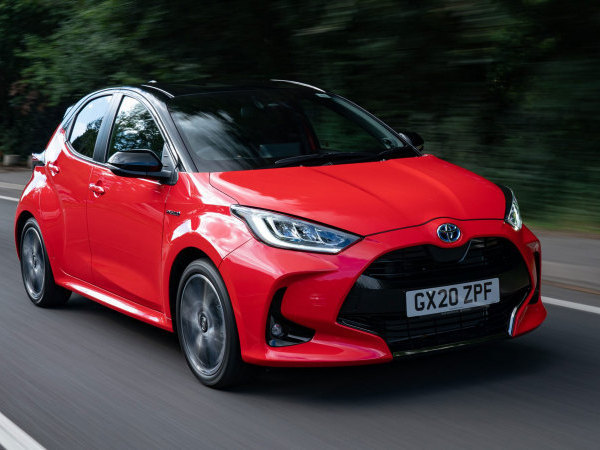Q
Does the 2020 RAV4 have battery issues?
The 2020 RAV4 had some reports of 12V battery issues in certain overseas markets, mainly that the battery might go dead after the vehicle sits for a long time. These problems are usually related to the battery being a bit on the small side or the electrical system drawing power continuously, but they aren't widespread. Toyota fixed it with a software update to optimize power management, and they also suggest owners start the engine periodically or use a battery maintainer if they're not going to drive the car for a while. The hybrid version's lithium-ion high-voltage battery system has stayed pretty reliable, with hardly any trouble reported. In daily use, try not to rely too much on always-on devices like parking monitors, and checking the battery's health regularly can help prevent issues. Batteries typically last 2-5 years, and humid climates speed up electrode corrosion, so it's a good idea to get a professional check every 3 years. A little-known detail is that the hybrid models' regenerative braking system actually helps extend the battery life. If you have trouble starting the car, first check simple things like leaving an interior light on by mistake—those little oversights are more common than actual battery failures.
Special Disclaimer: This content is published by users and does not represent the views or position of PCauto.
Related Q&A
Q
Where is the 12 volt battery in a 2020 RAV4 hybrid?
The 12-volt battery in the 2020 RAV4 Hybrid is located under the cover on the right side of the trunk. Just lift up the floor mat and remove the plastic cover to access it. This setup is designed to balance the hybrid system's weight distribution and free up space in the engine bay. Hybrid models often relocate the traditional lead-acid battery to the trunk because the engine compartment needs more room for the high-voltage battery pack and motor systems. Plus, the trunk location helps avoid the high-temperature environment that can shorten battery life. It's important to note that if you need to replace or service this battery, it's best to have a professional technician handle it. Hybrid systems involve high-voltage circuits, so improper handling could be risky. In daily use, you can monitor its status through the battery indicator light on the dashboard. If you experience starting problems or notice issues with electronic devices, it might mean the 12-volt battery is low on charge. In that case, you can try jump-starting it with jumper cables, but make sure to connect the positive and negative terminals correctly. The 12-volt battery in a hybrid car is mainly used to start the vehicle and power the low-voltage systems, with a clear division of labor from the high-voltage battery pack. This design effectively improves energy efficiency.
Q
What is the maintenance schedule for a 2020 RAV4?
For the 2020 RAV4, it's recommended to get basic maintenance every 6 months or 10,000 kilometers, whichever comes first. Basic maintenance includes an oil change, oil filter replacement, and regular checks like tires, brakes, lights, and the chassis. Every 20,000 kilometers, you'll need to swap out the air filter and cabin air filter. At 40,000 kilometers, it's a good idea to inspect or replace the brake fluid and transmission fluid. When you hit 80,000 kilometers, pay attention to the condition of components like the spark plugs and drive belt.
In daily use, make sure to regularly check tire pressure and windshield wipers to keep things safe on the road. The RAV4 is a tough SUV, and sticking to the official maintenance schedule will really help extend its life and keep it performing well. If you have the hybrid version, don't forget to take extra care of the battery system's cooling and maintenance.
If you often drive in stop-and-go traffic or super hot conditions, you might want to shorten the maintenance intervals a bit. Using original parts is always better since they match the vehicle perfectly. While you're at it, ask the technician to update the in-car software too—it can help optimize system performance.
Q
What is a 2020 RAV4 Hybrid worth?
Used 2020 RAV4 Hybrid prices typically range from RM110,000 to RM140,000 in the secondary market, depending on factors like condition, mileage, trim level, and remaining warranty. Higher-spec XSE or Limited variants usually command a 10-15% premium over the base LE. Powering this SUV is a 2.5L four-cylinder hybrid system, delivering around 4.7L/100km combined fuel economy. The battery pack generally comes with an 8-year/160,000km warranty, so second-hand buyers should definitely check the battery health report. Among its hybrid SUV peers, it holds value relatively well, thanks largely to Toyota's proven hybrid tech and low maintenance costs – regular services are needed every 10,000km, costing roughly RM300 to RM500 each time. If considering a trade-in, it's smart to get an appraisal from Toyota's certified pre-owned program first; these certified vehicles usually come with extended warranties and have undergone thorough inspections. Notably, 2020 marked the second year of local assembly for the fifth-gen RAV4 Hybrid, meaning better parts availability and shorter repair wait times compared to the earlier imported versions – a definite plus for long-term ownership costs.
Q
How long does a 2020 RAV4 battery last?
The factory battery in the 2020 RAV4 typically lasts between 3 to 5 years, depending on usage habits and environmental factors. Things like frequent short trips, long periods of inactivity, or hot and humid climates can shorten its life, while regular maintenance and avoiding deep discharges help extend it. The RAV4 usually comes with a maintenance-free lead-acid battery—if you notice starting issues, dim headlights, or slow electronics, it’s a good idea to check the battery status ASAP. For daily care, cut down on using accessories with the engine off and clean corrosion from the terminals regularly. Hybrid models might have slightly longer auxiliary battery life, but still pay attention to system alerts. I recommend a professional check every 2 years to plan for replacement before a sudden failure, and stick to batteries that match the original specs for best compatibility.
Q
How much does a 2020 RAV4 Hybrid battery cost?
The replacement cost for the hybrid battery of a 2020 RAV4 Hybrid ranges from approximately RM15,000 to RM30,000, depending on the battery type (original or third-party), warranty status, and the choice of repair shop. Original batteries are generally more expensive but come with a warranty, while third-party options may be more budget-friendly but require careful selection of reliable suppliers. Hybrid batteries typically last 8 to 10 years or longer, and regular maintenance such as avoiding overcharging and deep discharging can extend their lifespan. If the battery fails, it's advisable to first check if the vehicle is still under warranty, as Toyota usually offers an 8-year or 100,000-mile (about 160,000 km) battery warranty. Additionally, although the maintenance cost of the hybrid system is relatively higher, its excellent long-term fuel economy can offset some of the extra expenses. If considering battery replacement, it's recommended to consult an authorized service center for an accurate quote and inquire about any eco-friendly subsidy programs for recycling old batteries.
Q
Do 2020 RAV4s have CVT transmission?
The 2020 RAV4 doesn't come with a CVT transmission. Instead, the gas-powered versions get a traditional 8-speed automatic (8AT) as standard, while the hybrid models use Toyota's ECVT system—a power-split device specifically designed for hybrids, which has a different structure and operating principle than a regular CVT. Toyota went with 8AT and ECVT in the RAV4 to better balance power delivery, fuel efficiency, and driving feel. The 8AT offers more direct shift sensations, ideal for drivers who prefer a classic driving style, while the ECVT delivers smooth acceleration and efficient energy use through the coordinated work of the electric motor and engine. If you're into transmission tech, it's worth checking out the differences between CVTs and traditional automatics. CVTs use a steel strip and pulleys for stepless speed changes, excelling at smoothness and fuel economy but leaving some drivers missing that sporty feel. Traditional automatics, with their fixed gear ratios, provide clearer shift feedback—perfect for those who love a more engaging, hands-on driving experience.
Q
Does the 2020 Toyota RAV4 have a timing belt or chain?
The 2020 Toyota RAV4 comes equipped with a timing chain instead of a timing belt. This design offers advantages in terms of durability and maintenance costs—unlike a timing belt, which needs regular replacement, a timing chain typically lasts the lifetime of the engine with proper maintenance. Made of metal, timing chains are more resistant to high temperatures and wear compared to rubber belts. While they might produce slightly more noise during operation, modern technology has significantly mitigated this issue. Most current Toyota models, such as the Corolla and Camry, feature similar designs, reflecting the trend in modern engines toward long-term reliability. If you're unsure about your vehicle's specifications, it's advisable to check the owner's manual or consult an authorized service center. Although chains have a long lifespan, regular inspection of the tensioner and guide rail conditions is still necessary. Additionally, using the recommended engine oil to ensure proper lubrication is crucial for extending the chain's life.
Q
How long does the 2020 RAV4 Hybrid battery last?
The hybrid battery lifespan of the 2020 RAV4 Hybrid typically ranges from 8 to 10 years, depending on driving habits and maintenance. The nickel-metal hydride battery pack in this model is known for its durability, with most owners reporting it can last between 150,000 to 200,000 kilometers under normal driving conditions. Toyota offers an original factory warranty for the hybrid battery of up to 8 years or 100,000 kilometers (whichever comes first), and warranty policies may be more favorable in some regions, so it's advisable to check with local dealers for specific terms. In daily use, avoiding frequent deep charging and discharging, keeping the battery level around 50% during long-term storage, and regularly conducting battery health checks can effectively extend battery life. It's worth noting that unlike pure electric vehicle batteries, hybrid batteries operate in a gentler mode (shallow charging and discharging), so the actual degradation rate is usually slower than expected, and they can still function normally even when capacity drops to 70%. If battery replacement is needed, official refurbished parts or third-party repair solutions can significantly reduce costs, and there are now technical service providers specializing in hybrid battery repair in the market.
Q
Is the 2020 RAV4 AWD or 4wd?
The 2020 RAV4 comes with an AWD (All-Wheel Drive) system instead of the traditional 4WD (Four-Wheel Drive). This setup, called Dynamic Torque Vectoring AWD, can dynamically distribute torque between the front and rear wheels, as well as between the left and right rear wheels, to boost handling stability on slippery roads or through corners. Unlike 4WD systems that require manual switching, the AWD here is fully computer-controlled. It runs primarily in front-wheel drive during daily driving to save fuel, only kicking in automatically when wheel slip is detected—making it a better fit for city streets and light off-roading. Notably, hybrid models add an independent rear axle motor to this system, further enhancing its ability to get out of tricky spots. If you frequently encounter wet roads during the rainy season or occasionally need to tackle muddy paths, the RAV4’s AWD system provides ample safety. But for serious off-roading, you’d be better off looking at a rugged SUV with a low-range 4WD mode.
Q
How much is a 2020 Toyota RAV4 worth today?
The 2020 Toyota RAV4 is currently fetching around RM100,000 to RM140,000 on the used car market. Prices can vary depending on condition, mileage, trim level, and service history, with high-spec hybrid or top-of-the-line models potentially edging closer to RM150,000. It's a common sight locally, popular for its reliable build and low maintenance costs – especially the 2.0L naturally aspirated and hybrid variants, which stand out for fuel efficiency. The used car market generally agrees the RAV4 holds its value well. Before buying, it's smart to get a professional inspection to check the vehicle's condition and compare quotes from multiple dealers to land a fair price. Also, the current RAV4 sits on the TNGA platform, offering noticeably better handling and safety than its predecessor. If your budget allows, it's worth checking out new car deals too – some dealers might have attractive trade-in offers.
Latest Q&A
Q
Where is the 12 volt battery in a 2020 RAV4 hybrid?
The 12-volt battery in the 2020 RAV4 Hybrid is located under the cover on the right side of the trunk. Just lift up the floor mat and remove the plastic cover to access it. This setup is designed to balance the hybrid system's weight distribution and free up space in the engine bay. Hybrid models often relocate the traditional lead-acid battery to the trunk because the engine compartment needs more room for the high-voltage battery pack and motor systems. Plus, the trunk location helps avoid the high-temperature environment that can shorten battery life. It's important to note that if you need to replace or service this battery, it's best to have a professional technician handle it. Hybrid systems involve high-voltage circuits, so improper handling could be risky. In daily use, you can monitor its status through the battery indicator light on the dashboard. If you experience starting problems or notice issues with electronic devices, it might mean the 12-volt battery is low on charge. In that case, you can try jump-starting it with jumper cables, but make sure to connect the positive and negative terminals correctly. The 12-volt battery in a hybrid car is mainly used to start the vehicle and power the low-voltage systems, with a clear division of labor from the high-voltage battery pack. This design effectively improves energy efficiency.
Q
What is the maintenance schedule for a 2020 RAV4?
For the 2020 RAV4, it's recommended to get basic maintenance every 6 months or 10,000 kilometers, whichever comes first. Basic maintenance includes an oil change, oil filter replacement, and regular checks like tires, brakes, lights, and the chassis. Every 20,000 kilometers, you'll need to swap out the air filter and cabin air filter. At 40,000 kilometers, it's a good idea to inspect or replace the brake fluid and transmission fluid. When you hit 80,000 kilometers, pay attention to the condition of components like the spark plugs and drive belt.
In daily use, make sure to regularly check tire pressure and windshield wipers to keep things safe on the road. The RAV4 is a tough SUV, and sticking to the official maintenance schedule will really help extend its life and keep it performing well. If you have the hybrid version, don't forget to take extra care of the battery system's cooling and maintenance.
If you often drive in stop-and-go traffic or super hot conditions, you might want to shorten the maintenance intervals a bit. Using original parts is always better since they match the vehicle perfectly. While you're at it, ask the technician to update the in-car software too—it can help optimize system performance.
Q
What is a 2020 RAV4 Hybrid worth?
Used 2020 RAV4 Hybrid prices typically range from RM110,000 to RM140,000 in the secondary market, depending on factors like condition, mileage, trim level, and remaining warranty. Higher-spec XSE or Limited variants usually command a 10-15% premium over the base LE. Powering this SUV is a 2.5L four-cylinder hybrid system, delivering around 4.7L/100km combined fuel economy. The battery pack generally comes with an 8-year/160,000km warranty, so second-hand buyers should definitely check the battery health report. Among its hybrid SUV peers, it holds value relatively well, thanks largely to Toyota's proven hybrid tech and low maintenance costs – regular services are needed every 10,000km, costing roughly RM300 to RM500 each time. If considering a trade-in, it's smart to get an appraisal from Toyota's certified pre-owned program first; these certified vehicles usually come with extended warranties and have undergone thorough inspections. Notably, 2020 marked the second year of local assembly for the fifth-gen RAV4 Hybrid, meaning better parts availability and shorter repair wait times compared to the earlier imported versions – a definite plus for long-term ownership costs.
Q
How long does a 2020 RAV4 battery last?
The factory battery in the 2020 RAV4 typically lasts between 3 to 5 years, depending on usage habits and environmental factors. Things like frequent short trips, long periods of inactivity, or hot and humid climates can shorten its life, while regular maintenance and avoiding deep discharges help extend it. The RAV4 usually comes with a maintenance-free lead-acid battery—if you notice starting issues, dim headlights, or slow electronics, it’s a good idea to check the battery status ASAP. For daily care, cut down on using accessories with the engine off and clean corrosion from the terminals regularly. Hybrid models might have slightly longer auxiliary battery life, but still pay attention to system alerts. I recommend a professional check every 2 years to plan for replacement before a sudden failure, and stick to batteries that match the original specs for best compatibility.
Q
How much does a 2020 RAV4 Hybrid battery cost?
The replacement cost for the hybrid battery of a 2020 RAV4 Hybrid ranges from approximately RM15,000 to RM30,000, depending on the battery type (original or third-party), warranty status, and the choice of repair shop. Original batteries are generally more expensive but come with a warranty, while third-party options may be more budget-friendly but require careful selection of reliable suppliers. Hybrid batteries typically last 8 to 10 years or longer, and regular maintenance such as avoiding overcharging and deep discharging can extend their lifespan. If the battery fails, it's advisable to first check if the vehicle is still under warranty, as Toyota usually offers an 8-year or 100,000-mile (about 160,000 km) battery warranty. Additionally, although the maintenance cost of the hybrid system is relatively higher, its excellent long-term fuel economy can offset some of the extra expenses. If considering battery replacement, it's recommended to consult an authorized service center for an accurate quote and inquire about any eco-friendly subsidy programs for recycling old batteries.
View MoreRelated News

2026 Toyota RAV4 to Launch in China as the Wildlander
MichaelAug 13, 2025

2026 Toyota RAV4 Debuts: Stunning Inside & Out!
WilliamMay 22, 2025

Want a Toyota Hybrid? Get Ready to Wait
LienMar 31, 2025

Brand-new Toyota RAV4 Spy Shots Revealed: TNGA-K platform, Power Upgraded!
RobertDec 3, 2024

Australian auto market data in July: Toyota RAV4 sales won the first place, PHEV models increased by
AshleyAug 6, 2024
View More













Pros
Cons